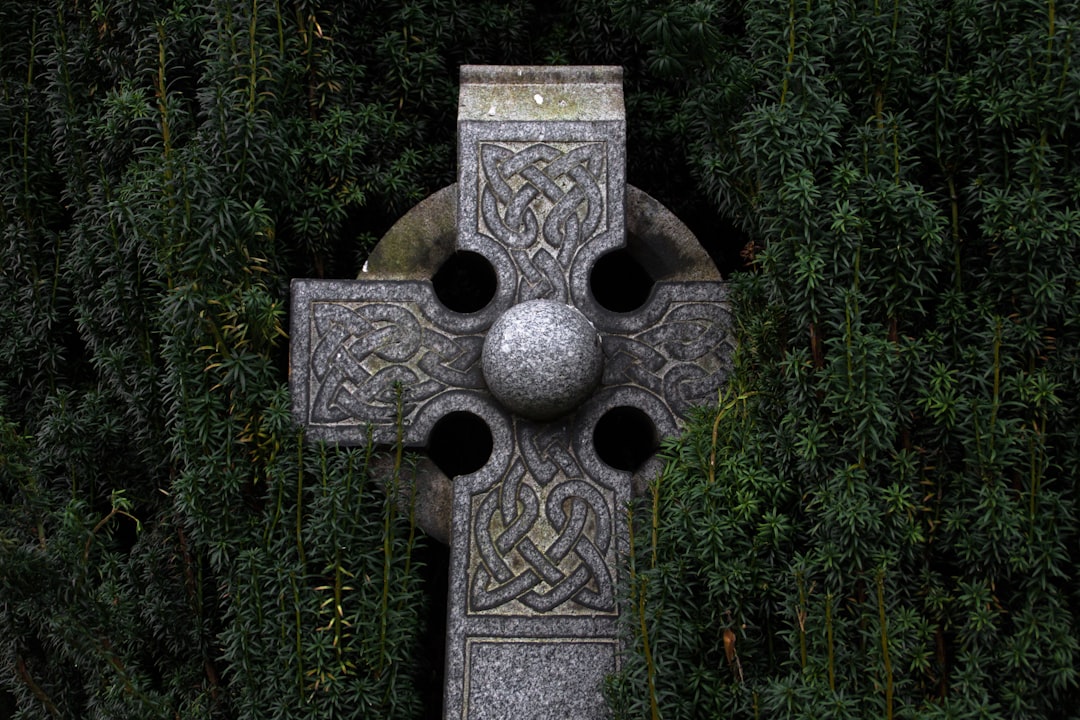 Photo from Unsplash
Photo from Unsplash
Originally Posted On: https://celtic-irishjewelry.com/blogs/celtic-irish-blog/celtic-symbol-for-family
The Celtic Symbol for Family: Meaning, History, Jewelry, Mythology, Religion, Art, and Famous Families
Celtic symbols have been a source of fascination for centuries. From intricate knotwork designs to powerful animal symbols, these ancient symbols have deep meanings and rich histories. One of the most meaningful Celtic symbols is the symbol for family. In this article, we’ll explore the meaning, history, jewelry, mythology, religion, art, and famous families associated with the Celtic symbol for family.
Meaning of the Celtic Symbol for Family
The Celtic symbol for family is a knotwork design that features a continuous line weaving in and out of itself to create a pattern that has no beginning or end. This symbol is often used to represent the bond between family members, which is believed to be unbreakable. The knots in the design are said to represent the interconnectedness of family members, and the fact that their lives are intertwined in a way that cannot be unraveled. The Celtic symbol for family is also thought to represent the idea of family as a source of strength and support. The knotwork design is complex and intricate, yet it is also strong and sturdy. This represents the idea that family members are there for each other, through thick and thin, and that they can rely on each other for support in times of need.
History of the Celtic Symbol for Family
The origins of the Celtic symbol for family can be traced back to ancient Celtic cultures, which existed in Europe during the Iron Age. These cultures were known for their intricate artwork and skilled craftsmanship, and they developed a unique style of knotwork design that featured in their artwork. The knotwork designs were often used to decorate everyday objects, such as clothing, weapons, and jewelry. They were also used to decorate important religious objects, such as crosses and chalices. Over time, the knotwork designs became more complex and intricate, and they came to be associated with important concepts, such as the interconnectedness of all living things. The Celtic symbol for family is believed to have been created during this time period, and it has since become a popular symbol in modern times.
Celtic Symbols of Family Jewelry
The Celtic symbol for family has been incorporated into many different types of jewelry, including rings, necklaces, bracelets, and earrings. These pieces often feature intricate knotwork designs that are meant to represent the bond between family members. One popular type of Celtic family jewelry is the Claddagh ring, which features a heart, a crown, and two hands. The heart represents love, the crown represents loyalty, and the hands represent friendship. The Claddagh ring is often given as a symbol of love and commitment between family members.
The Claddagh ring is a traditional Irish ring that has been worn for centuries as a symbol of love, loyalty, and friendship. This beautiful piece of jewelry is instantly recognizable by its distinctive design, which features two hands holding a heart, topped with a crown. The history of the Claddagh ring dates back to the 17th century in the town of Claddagh, which is located just outside of Galway City on the west coast of Ireland. The design of the ring is said to have been inspired by the fishing village’s seafaring culture, which was dominated by fishermen and sailors who were often away from home for long periods.
Legend has it that the original Claddagh ring was designed by a local goldsmith named Richard Joyce, who was captured by pirates and sold into slavery in Algeria. During his captivity, Joyce learned the craft of metalworking from his master and crafted the first Claddagh ring as a symbol of his love and loyalty to his hometown of Claddagh and the girlfriend he left behind. After his release, Joyce returned to Ireland and presented the ring to his beloved as a symbol of their enduring love. The Claddagh ring quickly became a popular symbol of love and friendship throughout Ireland and beyond.
The Claddagh ring’s unique design is steeped in symbolism. The hands represent friendship, the heart represents love, and the crown represents loyalty. When worn on the right hand with the heart facing outward, it is said to indicate that the wearer is single and looking for love. When worn on the right hand with the heart facing inward, it is said to indicate that the wearer is in a committed relationship. When worn on the left hand with the heart facing inward, it is said to indicate that the wearer is engaged. And when worn on the left hand with the heart facing outward, it is said to indicate that the wearer is married. In addition to its romantic symbolism, the Claddagh ring is also a symbol of Irish heritage and identity. The ring is often given as a gift to family members and friends as a way of expressing love, loyalty, and friendship. It is also a popular wedding ring and is often passed down through generations as a family heirloom.
Today, the Claddagh ring remains a beloved symbol of Irish culture and tradition. It is worn by people of all ages and backgrounds as a way of connecting with their Irish heritage and expressing their love and loyalty to the people they care about most. Whether worn as a wedding ring, a friendship ring, or a symbol of personal identity, the Claddagh ring is a timeless and meaningful piece of jewelry that will continue to be cherished for generations to come.
Other popular types of Celtic family jewelry include knotwork bracelets, which feature intricate knotwork designs that wrap around the wrist, and Celtic family tree necklaces, which feature a tree design with branches that represent different family members.
Shop our collection of Celtic Jewelry here: Tree of Life Jewelry – Celtic-IrishJewelry
Mythology about the Celtic Symbol for Family
In Celtic mythology, family was seen as one of the most important aspects of life. Many stories and legends focused on the relationships between family members, and the idea of the family bond was seen as sacred. One famous Celtic myth is the story of the Children of Lir. In this story, four children are transformed into swans by their jealous stepmother. They spend 900 years flying around Ireland, and during this time, they remain fiercely loyal to each other, despite the hardships they face. The story is often seen as a symbol of the unbreakable bond between family members.
Religion and the Celtic Symbol for Family
The Celtic symbol for family has been incorporated into many different religious traditions, including Christianity and Paganism. In Christianity, the knotwork design is often seen as a symbol of the Holy Trinity, which represents the Father, Son, and Holy Spirit, and their interconnectedness.
In Paganism, the Celtic symbol for family is often associated with the concept of the Mother Goddess, who is seen as the creator and nurturer of all life. The knotwork design is believed to represent the interconnectedness of all living things, and the idea that all beings are connected to the Mother Goddess in some way. The Pagan symbol for family is often associated with the concept of the Mother Goddess, who is seen as the creator and nurturer of all life. The symbol is often depicted as a circle with a dot in the center, which represents the all-encompassing nature of the Mother Goddess and the importance of the family unit in Paganism.
The history of the Pagan symbol for family can be traced back to ancient cultures, where the Mother Goddess was often worshipped as the supreme deity. In many cultures, the Mother Goddess was believed to have created all life and to have a special connection to the natural world. The symbol for family in Paganism represents the idea that all living things are interconnected and that the family unit is an important part of this interconnectedness. It also represents the idea that the Mother Goddess is the creator and nurturer of all life, and that she is the source of all love and compassion.
In Paganism, the family unit is seen as a sacred and important part of life. The family is believed to be the primary source of love and support, and it is seen as a place where individuals can grow and thrive. The Pagan symbol for family represents this importance and the deep connection that family members share. Today, the Pagan symbol for family is still used by many Pagans as a way to represent their family unit and the importance of the Mother Goddess in their lives. The symbol can be found on jewelry, clothing, and other items, and it is often used in Pagan rituals and ceremonies.
Overall, the Pagan symbol for family has a rich and complex history, and it continues to be an important symbol for many Pagans today. Whether you are a Pagan or simply appreciate the symbolism behind this ancient symbol, the Pagan symbol for family is a powerful reminder of the importance of family and the deep connection that we all share with each other and with the natural world.
Art and the Celtic Symbol for Family
The Celtic symbol for family has been incorporated into many different forms of art, including paintings, sculptures, and tapestries. The intricate knotwork designs are often used to create beautiful and complex patterns that are pleasing to the eye. One famous example of Celtic family art is the Book of Kells.
The Book of Kells is one of the most famous and magnificent illuminated manuscripts in the world. It is a masterpiece of early medieval art and one of Ireland’s greatest national treasures. The book contains the four gospels of the New Testament in Latin and is richly decorated with intricate and colorful illustrations, ornamental letters, and decorative borders. The origins of the Book of Kells can be traced back to the 9th century when it was created by Irish monks at the monastery of Kells, in County Meath, Ireland. The book is believed to have been produced between 800 and 1000 AD, during the height of the Golden Age of Irish art and culture. It is unclear who exactly created the book, but it is believed to have been the work of several scribes and artists over a period of several decades.
The Book of Kells was originally created as a symbol of the Christian faith and was intended to be a sacred object used for religious instruction and devotion. It was likely used during Mass and other religious services and would have been an impressive and awe-inspiring sight for the congregation. The book is known for its stunning illustrations and intricate designs, which feature a wide range of motifs, including animals, birds, plants, and abstract designs. The illustrations are executed with remarkable precision and skill, and the colors used are rich and vibrant, which adds to the book’s overall beauty and appeal.
In addition to its artistic merit, the Book of Kells is also an important historical document. It provides insight into the culture, religion, and daily life of the people of Ireland during the early medieval period. It is a testament to the skill and ingenuity of the Irish monks who created it, and it has been a source of inspiration and wonder for scholars, artists, and visitors alike. The Book of Kells has had a long and eventful history since its creation. It survived Viking raids and other threats, and it was eventually transferred to the monastery of Kells, where it remained until the 17th century. It was then moved to Trinity College in Dublin, where it has been housed ever since. Today, the book is considered one of Ireland’s greatest national treasures, and it is on display at Trinity College’s Old Library, where it continues to inspire and delight visitors from around the world.
Famous Celtic Families
Throughout history, there have been many famous Celtic families that have left their mark on the world. One famous example is the Kennedy family, who are known for their political achievements in the United States. The Kennedys are of Irish descent, and they have played a prominent role in American politics for many years. Another famous Celtic family is the Guinness family, who are known for their brewing empire.
The Guinness family has a rich and fascinating history that is deeply intertwined with the ancient culture of the Celts. The Celts were a group of tribal societies that lived throughout Europe during the Iron Age, and their culture and traditions have had a profound influence on Ireland’s history and identity. The Guinness family’s connection to Ireland can be traced back to the early 18th century when Arthur Guinness, a young entrepreneur, leased a disused brewery in Dublin and began brewing beer. Over time, Guinness’s brewery became one of the largest and most successful in Ireland, and the Guinness family became known for their philanthropy and support of Irish culture and heritage.
The Guinness family’s connection to the Celts is reflected in their company’s iconic symbol, the harp. The harp is an ancient Celtic symbol that has been used in Irish art and culture for centuries. It represents the connection between the physical world and the spiritual world, and it is a symbol of music, creativity, and wisdom. The Guinness family’s support of Irish culture and heritage can be seen in their patronage of the arts and their support of Irish traditions such as music, dance, and storytelling. They also played an important role in the preservation of Irish folklore and mythology, which are deeply rooted in Celtic culture.
The Guinness family’s commitment to Ireland’s cultural heritage is reflected in the creation of the Guinness Book of Records, which was first published in 1955. The book was initially created as a way of settling arguments in pubs over trivia questions, but it quickly became a global phenomenon and a celebration of human achievement and creativity. Today, the Guinness family continues to be a prominent and influential part of Irish society, and their legacy can be seen in the many charitable and cultural organizations they have supported over the years. They are a testament to the enduring influence of Celtic culture and the importance of preserving and celebrating Ireland’s rich heritage.
Conclusion
The Celtic symbol for family is a powerful and meaningful symbol that represents the bond between family members. The knotwork design is intricate and complex, yet it is also strong and sturdy, just like the bond between family members. The symbol has a rich history that can be traced back to ancient Celtic cultures, and it has been incorporated into many different forms of art and jewelry over the years. Whether you are looking for a piece of jewelry to represent your family bond, or you simply want to appreciate the beauty and meaning of the Celtic symbol for family, there is no denying the significance of this ancient symbol. So next time you see the knotwork design, remember the deep history and rich meaning behind it, and the unbreakable bond between family members that it represents.
Good day and good reading,
Jill Hecker







